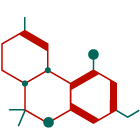The cannabinoids produced by the plant are in an acidic state. When heat is applied to them, or by the action of UV light, these cannabinoids transform into their neutral form. This process is known as decarboxilation. In this way, when Cannabis is smoked or vaporised, a considerable amount of the cannabinoids present change into their neutral form. However, if the sample is, for example, ingested, as no heat has been applied, the acidic cannabinoids will remain in their original state.

Thus, a different kind of analysis will be advisable depending on the kind of sample and its purpose.
Cannabinoid test using HPLC
Liquid chromatography does not use heat, so it is possible to identify and quantify both acidic and neutral cannabinoids. This is the most powerful method, as it shows the real content of cannabinoids present in the sample.
Type of sample recommended for analysis using HPLC: extracts and other products that will neither be smoked nor vaporised (products which will be ingested, creams, etc.). Nevertheless, it can also be used for testing products that will be smoked or vaporised, as with simple calculations it is possible to know the maximum amount of neutral cannabinoids that can be obtained by applying heat to the samples.
The cannabinoids that we can identify and quantify by using HPLC are:
- Acidic cannabinoids: CBDA, CBGA and THCA
- Neutral cannabinoids: CBD, CBDV, THC, THCV, CBG, CBN, CBC